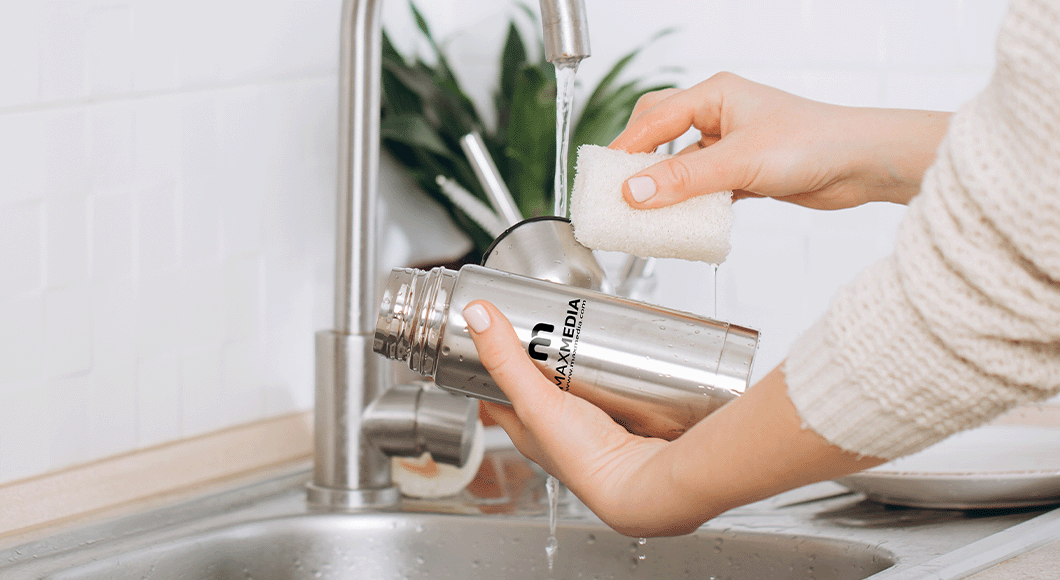
Whether you’ve gotten a new drinkware set to use at your business or were given something special from someone else, it’s important to know how to clean your cups and bottles properly. If you want to know how to sanitize glassware and other custom drinkware without damaging the imprint or the drinkware itself, read on to learn about handwashing, dishwashers, and which one fits your drinkware. Whether you have ceramic mugs, glitzy glassware, or travel mugs with high-quality insulation, how you care for your drinkware will impact how long you get the best use from them.
While some people find the act of handwashing their dishes therapeutic, most can agree that it’s easier to just put your dishes in a dishwasher. So then why do we hand wash our drinkware?
Dishwasher safe is a label given to drinkware that can be washed in the dishwasher without damage. While some are labeled as “top rack safe” or just “dishwasher safe”, you should take both to mean the same thing. Drinkware goes on the top rack, furthest from the heating element at the bottom of the dishwasher. Even dishwasher-safe ceramics should be kept at the top with custom drinkware to protect the imprint.
The only way to know for sure is if your custom drinkware is labeled as dishwasher safe. Without this label, hand-washing is always best to preserve your drinkware and its custom imprint. If you don’t have access to the original care instructions on your drinkware, check the bottom. Most dishwasher-safe drinkware will have a symbol on the bottom, side, or handle indicating that it is dishwasher safe. This symbol varies in design, but is typically a square with something to represent both a dish and water inside, like a cup and water droplet or a plate under and diagonal lines. Remember, this means the drinkware is dishwasher safe, but the custom imprint might still not be.
Still not completely sure if you should put it in the dishwasher? Here are some questions to ask yourself:
Tea and coffee can be tasty, but it contains something called tannins. This plant-based chemical is often used in tanning leather or making ink, and as you can guess, it stains. So how do you get those dark rings out of your favorite coffee mug? The best ways that don’t involve damaging your mug include one or all of the following:
While harsher detergents and bleach can work wonders, these gentle cleaners are less likely to cause damage to your new favorite custom mug.
Water bottle lids contain a lot of little ridges that can trap moisture and bacteria, breeding mold and other problems over time. So how do you clean it? Follow these steps to keep your favorite lids clean:
Not sure how to clean metal water bottle, or how to clean a glass bottle instead of a plastic one? Vinegar is a gentle but powerful cleaner for any type of water bottle, so don’t worry about the material unless you’re using bleach or something that could corrode the finish on your metal water bottle over time. Baking soda is more abrasive than vinegar, and while it is safe for most metals, it should be avoided for aluminium material.
No matter how you sanitize your glassware and drinkware, it’s important to keep in mind how your method affects your drinkware over time. Dishwashers are effective, but often too forceful on delicate materials. While hand-washing can be tedious, it can help protect your drinkware for longer lasting imprints and performance.
Whether you’re the band everyone is talking about, or a vendor looking to ride the wave of fame and get…
Wish you could turn your passion into a business? Meet Dash Diaz, owner of the popular Miami-based nursery, Plant Daddy!…
Not getting the visibility you need for your business to grow? Trade shows and conventions are an amazing way to…
In today's competitive landscape, consumers respond to unique offerings that feel homemade, hand selected, and special. If you're seeking a…
There are a lot of fun holidays out there, from World Emoji Day to International Cat Day. But right now,…
Reunite, renew, remember! Planning a family reunion is a fantastic way to reconnect loved ones, celebrate shared history, and forge…